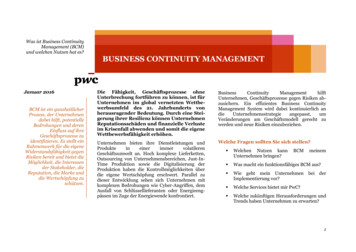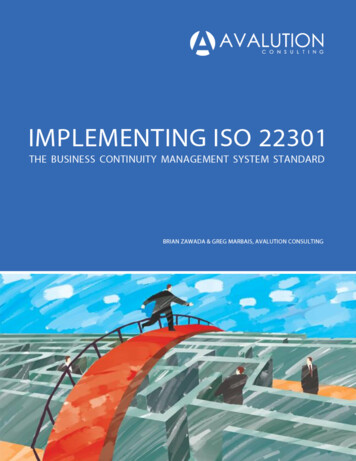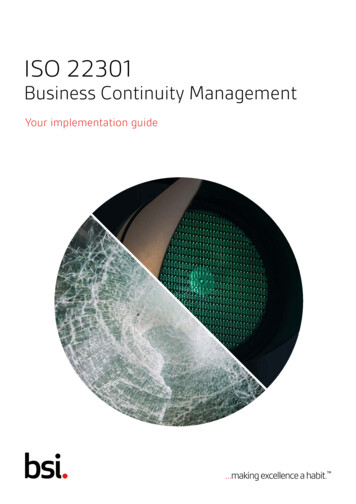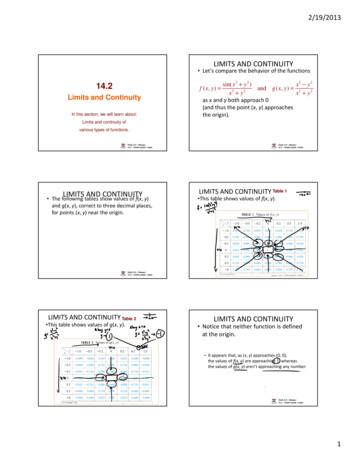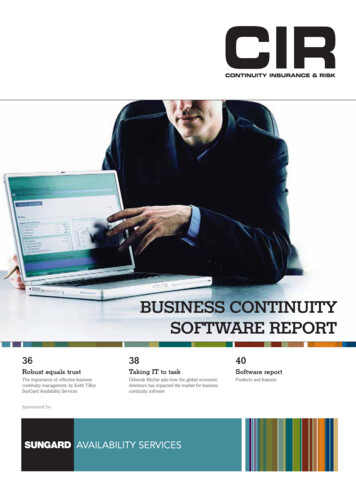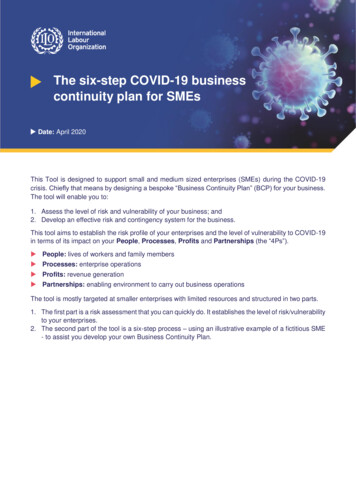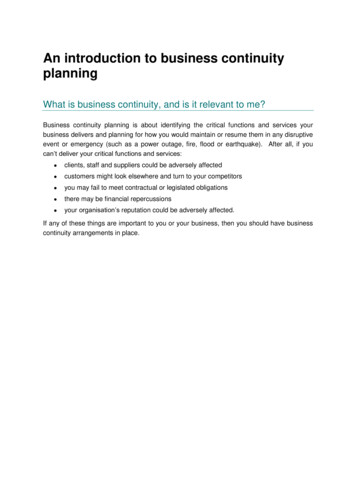
Transcription
Federal Financial Institutions Examination CouncilFFIECBusinessContinuity PlanningMARCH 2003IT EXAMINATIONHANDBOOKBCP
TABLE OF CONTENTSINTRODUCTION . 1BOARD AND SENIOR MANAGEMENT RESPONSIBILITIES . 3BUSINESS CONTINUITY PLANNING PROCESS . 4Business Impact Analysis . 6Risk Assessment . 8Risk Management . 10Business Continuity Plan Development . 10Other Policies, Standards and Processes. 12Systems Development Life Cycle and Project Management. 12Change Control . 13Data Synchronization . 13Employee Training and Communication Planning. 13Insurance . 14Government and Community . 15Risk Monitoring . 15Overall Testing Strategy. 15Testing Scope and Objectives. 16Specific Test Plans. 17Test Plan Review . 17Validation of Assumptions . 17Accuracy of Information. 18Completeness of Procedures . 18Testing Methods. 18ORIENTATION/WALK-THROUGH . 18TABLETOP/MINI-DRILL. 18FUNCTIONAL TESTING . 19FULL-SCALE TESTING . 19
Conducting a Test . 20Analyzing and Reporting Test Results . 20Updating a Business Continuity Plan . 21Audit and Independent Reviews. 21SUMMARY .22APPENDIX A: EXAMINATION PROCEDURES.A-1APPENDIX B: GLOSSARY .B-1APPENDIX C: INTERNAL AND EXTERNAL THREATS .C-1APPENDIX D: INTERDEPENDENCIES .D-1APPENDIX E: BCP COMPONENTS .E-1
Business Continuity Planning Booklet - March 2003INTRODUCTIONThis Federal Financial Institutions Examination Council (FFIEC) Business ContinuityPlanning booklet provides guidance and examination procedures to assist examiners inevaluating financial institution and service provider risk management processes to ensurethe availability of critical financial services.Operating disruptions can occur with or without warning, and the results may bepredictable or unknown. Because financial institutions play a crucial role in the UnitedStates economy, it is important their business operations are resilient and the effects ofdisruptions in service are minimized in order to maintain public trust and confidence inour financial system.1 Effective business continuity planning establishes the basis forfinancial institutions to maintain and recover business processes when operations havebeen disrupted unexpectedly.Business continuity planning is the process whereby financial institutions ensure themaintenance or recovery of operations, including services to customers, when confrontedwith adverse events such as natural disasters, technological failures, human error, orterrorism. The objectives of a business continuity plan (BCP) are to minimize financialloss to the institution; continue to serve customers and financial market participants; andmitigate the negative effects disruptions can have on an institution's strategic plans,reputation, operations, liquidity, credit quality, market position, and ability to remain incompliance with applicable laws and regulations. Changing business processes(internally to the institution and externally among interdependent financial servicescompanies) and new threat scenarios require financial institutions to maintain updatedand viable BCPs.Reviewing a financial institution's BCP is an established part of examinations performedby the FFIEC member agencies. 2 However, new business practices, changes intechnology, and increased terrorism concerns, have focused even greater attention on theneed for effective business continuity planning and have altered the benchmarks of aneffective plan. For example, an effective BCP should take into account the potential forwide-area disasters that impact an entire region and for the resulting loss orinaccessibility of staff. It also should consider and address interdependencies, bothmarket-based and geographic, among financial system participants as well asinfrastructure service providers. In most cases, recovery time objectives are now much1This booklet uses the terms "institution" and "financial institution" to describe insured banks, thrifts, and creditunions, as well as technology service providers that provide services to such entities.2Board of Governors of the Federal Reserve System, Federal Deposit Insurance Corporation, National CreditUnion Administration, Office of the Comptroller of the Currency, and Office of Thrift Supervision.FFIEC IT Examination HandbookPage 1
Business Continuity Planning Booklet - March 2003shorter than they were even a few years ago, and for some institutions recovery timeobjectives are based on hours and even minutes.Many financial institutions are incorporating business continuity considerations intobusiness process development to mitigate proactively the risk of service disruptions. Increating an effective BCP, financial institutions should not assume a reduced demand forservices during the disruption. In fact, demand for some services (e.g., ATMs) mayincrease.This booklet rescinds and replaces Chapter 10 of the 1996 FFIEC Information SystemsExamination Handbook, Corporate Contingency Planning. This update is necessary dueto advances since 1996 in technology, changes in business practices, and increasedconcerns over terrorism.This booklet also provides an opportunity to incorporate lessons learned from Year 2000activities. The Year 2000 activities recognized that while technology was the primarybasis for concern, an enterprise-wide, process-oriented approach that considerstechnology, business processes, testing, and communication strategies is critical tobuilding a viable BCP.Each primary section of the booklet begins with an “Action Summary” that summarizesand highlights the major themes in that section. While not a substitute for reading theentire booklet, these Action Summaries may be used to more quickly assess the mostimportant points discussed in that section.FFIEC IT Examination HandbookPage 2
Business Continuity Planning Booklet - March 2003BOARD AND SENIORMANAGEMENT RESPONSIBILITIESAction SummaryA financial institution's board of directors and senior management areresponsible for:Allocating sufficient resources and knowledgeable personnel todevelop the BCP;Setting policy by determining how the institution will manage andcontrol identified risks;Reviewing BCP test results;Approving the BCP on an annual basis; andEnsuring the BCP is kept up-to-date and employees are trainedand aware of their role in its implementation.Senior management and the board of directors are responsible for identifying, assessing,prioritizing, managing, and controlling risks. They should ensure necessary resources aredevoted to creating, maintaining, and testing the plan. The board fulfills its businesscontinuity planning responsibilities by setting policy, prioritizing critical businessfunctions, allocating sufficient resources and personnel, providing oversight, approvingthe BCP, reviewing test results, and ensuring maintenance of a current plan. Theeffectiveness of business continuity planning depends on management's commitment andability to clearly identify what makes existing business processes work. Each financialinstitution must evaluate its own unique circumstances and environment to develop acomprehensive BCP.The board and senior management should designate personnel to participate in BCPdevelopment. Properly allocating resources will challenge an institution throughout thedevelopment and maintenance of a BCP. A large, complex institution may need abusiness continuity planning department with a team of departmental liaisons throughoutthe enterprise. A smaller, less complex institution may only need an individual businesscontinuity planning coordinator. While the planning personnel may recommend certainprioritization, ultimately the board of directors and senior management are responsiblefor understanding critical business processes and subsequently establishing plans to meetbusiness process requirements in a safe and sound manner.FFIEC IT Examination HandbookPage 3
Business Continuity Planning Booklet - March 2003BUSINESS CONTINUITY PLANNINGPROCESSAction SummaryA financial institution's business continuity planning process shouldreflect the following objectives:Business continuity planning is about maintaining, resuming, andrecovering the business, not just the recovery of the technology.The planning process should be conducted on an enterprise-widebasis.A thorough business impact analysis and risk assessment are thefoundation of an effective BCP.The effectiveness of a BCP can only be validated through testingor practical application.The BCP and test results should be subjected to an independentaudit and reviewed by the board of directors.A BCP should be periodically updated to reflect and respond tochanges in the financial institution or its service provider(s).Financial institutions should conduct business continuity planning on an enterprise-widebasis. In enterprise-wide business continuity planning an institution considers everycritical aspect of its business in creating a plan for how it will respond to disruptions. Itis not limited to the restoration of information technology systems and services, or datamaintained in electronic form, since such actions, by themselves, cannot always put aninstitution back in business. Without a BCP that considers every critical business unit,including personnel, physical workspace, and similar issues, an institution may not beable to resume serving its customers at acceptable levels. Institutions that outsource themajority of their data processing, core processing, or other information technologysystems or services are still expected to implement an appropriate BCP addressing theequipment and processes that remain under their control.Financial institutions should also recognize their role in supporting systemic financialmarket business processes (e.g., inter-bank payment systems, and key market clearanceand settlement activities) and that service disruptions at their institution may significantlyaffect the integrity of key financial markets. The FFIEC agencies encourage allinstitutions to work with affected interdependent parties to coordinate BCP developmentand testing. The FFIEC agencies expect financial institutions that play a major role incritical financial markets to have robust planning and coordinated testing with otherindustry participants. Critical markets include, but may not be limited to, the markets forFFIEC IT Examination HandbookPage 4
Business Continuity Planning Booklet - March 2003federal funds; foreign exchange; commercial paper; and government, corporate, andmortgage-backed securities.Firms that play significant roles in critical financial markets are those that participate insufficient volume or value such that their failure to perform critical activities by the endof the business day could present systemic risk. The agencies believe that many, if notmost, of the 15-20 major banks and the 5-10 major securities firms, and possibly others,play at least one significant role in at least one critical market. In the context of soundpractices, some of the agencies are considering the benefit of providing additionalguidance to help firms identify the category into which they fall for the specific activitiesthey perform.Financial institutions not directly participating in critical financial markets, butnonetheless performing financial services or supporting financial market activitiesdeemed critical to regional or national financial sectors, are also expected to establishBCPs and recovery capabilities commensurate with their role. Smaller, less complexinstitutions generally do not need the same level of planning, but are expected to fulfilltheir responsibility by developing an appropriate BCP and periodically conductingadequate tests.Management should update BCPs as business processes change. For example, financialinstitutions of all sizes are increasingly relying on distributed network solutions tosupport business processes. This increased reliance can include desktop computersmaintaining key applications. While distributed networking provides flexibility inallowing institutions to deliver operations to where employees and customers are located,it also means that end-users should keep BCP personnel up-to-date on what constitutescurrent business processes and significant changes. Technological advancements areallowing faster and more efficient processing, thereby reducing acceptable businessprocess recovery periods. In response to competitive and customer demands, manyfinancial institutions are moving toward shorter recovery periods and designingtechnology recovery solutions into business processes.These technologicaladvancements increase the importance of enterprise-wide business continuity planning.The FFIEC agencies encourage financial institutions to adopt a process-oriented approachto business continuity planning that involves:1. Business impact analysis (BIA);2. Risk assessment;3. Risk management; and4. Risk monitoring.This framework is usable regardless of the size of the institution. Business continuityplanning should focus on all critical business functions that need to be recovered toFFIEC IT Examination HandbookPage 5
Business Continuity Planning Booklet - March 2003resume operations. Continuity planning for technology alone should no longer be theprimary focus of a BCP, but rather viewed as one critical aspect of the enterprise-wideprocess. The review of each critical business function should include the technology thatsupports it.3BUSINESS IMPACT ANALYSISAction SummaryA business impact analysis (BIA) is the first step in developing a BCP. Itshould include:Identification of the potential impact of uncontrolled, non-specificevents on the institution's business processes and its customers;Consideration of all departments and business functions, not justdata processing; andEstimation of maximum allowable downtime and acceptable levelsof data, operations, and financial losses.The institution’s first step in developing a BCP is to perform a BIA. The amount of timeand resources necessary to complete the BIA will depend on the size and complexity ofthe financial institution. The institution should include all business functions anddepartments in this process, not just data processing.The BIA phase identifies the potential impact of uncontrolled, non-specific events on theinstitution's business processes. The BIA phase also should determine what and howmuch is at risk by identifying critical business functions and prioritizing them. It shouldestimate the maximum allowable downtime for critical business processes, recovery pointobjectives and backlogged transactions, and the costs associated with downtime.Management should establish recovery priorities for business processes that identifyessential personnel, technologies, facilities, communications systems, vital records, anddata. The BIA also considers the impact of legal and regulatory requirements such as theprivacy and availability of customer data and required notifications to the institution'sprimary federal regulator and customers when facilities are relocated.43See Guidelines for Establishing Standards for Safeguarding Customer Information, 66 FR 8616 (February 1,2001). The risk assessment required by the interagency guidelines may be helpful in performing the BCP riskassessment. Board of Governors of the Federal Reserve System, 12 CFR parts 208, 211, 225, and 263; FederalDeposit Insurance Corporation, 12 CFR parts 308 and 364; National Credit Union Administration, 12 CFR part748; Office of the Comptroller of the Currency, 12 CFR part 30; Office of Thrift Supervision, 12 CFR parts 568and 570.4See Policy Statement of the Office of the Comptroller of the Currency, Board of Governors of the FederalReserve System, Federal Deposit Insurance Corporation, and Office of Thrift Supervision Concerning BranchFFIEC IT Examination HandbookPage 6
Business Continuity Planning Booklet - March 2003Personnel responsible for this phase should consider developing uniform interview andinventory questions that can be used on an enterprise-wide basis. Uniformity canimprove the consistency of responses and help personnel involved in the BIA phasecompare and evaluate business process requirements. This phase may initially prioritizebusiness processes based on their importance to the institution's achievement of strategicgoals and maintenance of safe and sound practices. However, this prioritization shouldbe revisited once the business processes are modeled against various threat scenarios sothat a BCP can be developed.When determining a financial institution's critical needs, reviews should be conducted forall functions, processes, and personnel within each department. Each department shoulddocument the mission critical functions performed. Departments should consider thefollowing questions:What specialized equipment is required and how it is used?How would the department function if mainframe, network and/orInternet access were not available?What single points of failure exist and how significant are thoserisks?What are the critical outsourced relationships and dependencies?What is the minimum number of staff and space that would berequired at a recovery site?What special forms or supplies would be needed at a recovery site?What communication devices would be needed at a recovery site?What critical operational or security controls require implementationprior to recovery?Is there any potential impact from common recovery sites servingmultiple lines of business or departments?Have employees received cross training and has the departmentdefined back-up functions/roles employees should perform if keypersonnel are not available?Are emotional support and family care needs adequately considered?Closing Notices and Policies, 64 FR 34844 (June 30, 1999); Establishment and Relocation of Domestic Branchesand Offices, Board of Governors of the Federal Reserve System, 12 CFR part208.6; Federal Deposit InsuranceCorporation, 12 CFR part 303.44; Office of the Comptroller of the Currency, 12 CFR part5.30; and Office ofThrift Supervision, 12 CFR part545.95.FFIEC IT Examination HandbookPage 7
Business Continuity Planning Booklet - March 2003RISK ASSESSMENTAction SummaryThe risk assessment is the second step in developing a BCP. It shouldinclude:A prioritizing of potential business disruptions based upon severityand likelihood of occurrence;A gap analysis comparing the institution's existing BCP, if any, towhat is necessary to achieve recovery time and point objectives;andAn analysis of threats based upon the impact on the institution, itscustomers, and the financial markets, not just the nature of thethreat.The risk assessment step is critical and has significant bearing on whether businesscontinuity planning efforts will be successful. If the threat scenarios developed areunreasonably limited, the resulting BCP may be inadequate. During the risk assessmentstep, business processes and the business impact analysis assumptions are stress testedwith various threat scenarios. This will result in a range of outcomes, some that requireno action for business processes to be successful and others that will require significantBCPs to be developed and supported with resources (financial and personnel).Financial institutions should develop realistic threat scenarios that may potentially disrupttheir business processes and ability to meet their client’s expectations (internal, businesspartners, or customers).5 Threats can take many forms, including malicious activity aswell as natural and technical disasters. Where possible, institutions should analyze athreat by focusing on its impact on the institution, not the nature of the threat. Forexample, the effects of certain threat scenarios can be reduced to business disruptions thataffect only specific work areas, systems, facilities (i.e., buildings), or geographic areas.Additionally, the magnitude of the business disruption should consider a wide variety ofthreat scenarios based upon practical experiences and potential circumstances and events.If the threat scenarios are not comprehensive, BCPs may be too basic and omitreasonable steps that could improve business processes' resiliency to disruptions.Threat scenarios need to consider the impact of a disruption and probability of the threatoccurring. Threats range from those with a high probability of occurrence and lowimpact to the institution (e.g., brief power interruptions), to those with a low probability5A summary of threats and basic safeguards is contained in Appendix C.FFIEC IT Examination HandbookPage 8
Business Continuity Planning Booklet - March 2003of occurrence and high impact on the institution (e.g., hurricane, terrorism). Highprobability threats are often supported by very specific BCPs. However, the mostdifficult threats to address are those that have a high impact on the institution but a lowprobability of occurrence. Using a risk assessment, BCPs may be more flexible andadaptable to specific types of disruptions that may not be initially considered.It is at this point in the business continuity planning process that financial institutionsshould perform a "gap analysis." In this context, a gap analysis is a methodicalcomparison of what types of plans the institution (or business line) needs to maintain,resume, or recover normal business operations in the event of a disruption, versus whatthe existing BCP provides. The difference between the two highlights additional riskexposure that management and the board need to address in BCP development.The risk assessment considers:The impact of various business disruption scenarios on both theinstitution and its customers;The probability of occurrence based, for example, on a rating systemof high, medium, and low;The loss impact on information services, technology, personnel,facilities, and service providers from both internal and externalsources;The safety of critical processing documents and vital records; andA broad range of possible business disruptions, including natural,technical, and human threats.When assessing the probability of a specific event occurring, financial institutions andtechnology service providers should consider the geographic location of facilities andtheir susceptibility to natural threats (e.g., location in a flood plain), and the proximity tocritical infrastructures (e.g., power sources, nuclear power plants, airports, points ofinterest, major highways, railroads).The risk assessment should include all the financial institution or service provider'slocations and facilities. Worst-case scenarios, such as destruction of the facilities andloss of life, should be considered. At the conclusion of this phase, the institution willhave prioritized business processes and estimated how they may be disrupted undervarious threat scenarios.FFIEC IT Examination HandbookPage 9
Business Continuity Planning Booklet - March 2003RISK MANAGEMENTBUSINESS CONTINUITY PLAN DEVELOPMENTAction SummaryRisk management is the development of a written, enterprise-wideBCP. The institution should ensure that the BCP is:Written and disseminated so that various groups of personnel canimplement it in a timely manner;Specific regarding what conditions should prompt implementationof the plan;Specific regarding what immediate steps should be taken during adisruption;Flexible to respond to unanticipatedchanging internal conditions;threatscenariosandFocused on how to get the business up and running in the eventthat a specific facility or function is disrupted, rather than on theprecise nature of the disruption; andEffective in minimizing service disruptions and financial loss.After conducting the BIA and risk assessment, management should prepare a writtenBCP. The plan should document strategies and procedures to maintain, resume, andrecover critical business functions and processes and should include procedures toexecute the plan’s priorities for critical vs. non-critical functions, services and processes.A well-written BCP should describe in some detail the types of events that would lead upto the formal declaration of a disruption and the process for invoking the BCP. It shoulddescribe the responsibilities and procedures to be followed by each continuity team andcontain contact lists of critical personnel. The BCP should describe in detail theprocedures to be followed to recover each business function affected by the disruptionand should be written in such a way that various groups of personnel can implement it ina timely manner.As previously discussed, a BCP is more than recovery of the technology, but rather arecovery of all critical business operations. The plan should be flexible to respond tochanging internal and external conditions and new threat scenarios. Rather than beingdeveloped around specific events (e.g. fire vs. tornado), the plan will be more effective ifit is written to adequately address specific types of scenarios and the desired outcomes.A BCP should describe the immediate steps to be taken during an event in order tominimize the damage from a disruption, as well as the action necessary to recover. Thus,business continuity planning should be focused on maintaining, resuming, and recoveringFFIEC IT Examination HandbookPage 10
Business Continuity Planning Booklet - March 2003the institution's operations after a disruption. Specific scenarios should include how thefinancial institution would respond if:Critical personnel are not available;Critical buildings, facilities, or geographic regions are not accessible;Equipment malfunctions (hardware, telecommunications, operationalequipment);Software and data are not accessible or are corrupted;Vendor assistance or service provider is not available;Utilities are not available (power, telecommunications); andCritical documentation and/or records are not available.Financial institutions should carefully consider the assumptions on which the BCP isbased. Institutions should not assume a disaster will be limited to a single facility or asmall geographic area. Institutions should not assume they will be able to gain access tofacilities that have not been damaged or that critical personnel (including seniormanagement) will be available immediately after the disruption. Assuming publictransportation systems such as airlines, railroads and subways will be operating may alsobe incorrect. Financial institutions should not assume the telecommunications systemwill be operating at normal capacity.A BCP consists of many components that are both internal and external to a financialinstitution. The activation of a continuity plan and restoration of business in the event ofan emergency is dependent on the successful interaction of various components. Theoverall strength and effectiveness of a BCP can be decreased by its weakest component.An effective business continuity plan coordinates across its many components, identifiespotential process or system dependencies, and mitigates the risks frominterdependencies.6Typically, the business continuity coordinator or team facilitates the identification of riskand the development of risk mitigation strategies across business areas. Internal causesof interdependencies can include line of business dependencies, telecommunication links,and/or shared resources (i.e., print operations or e-mail systems). External sources ofinterdependencies that can negatively impact a business continuity plan can includetelecommunication providers, service providers, customers, business partners andsuppliers.76A more comprehensive discussion of interdependencies is contained in Appendix D.7A more complete discussion of business continuity plan components is contained in Appendi
The BCP and test results should be subjected to an independent audit and reviewed by the board of directors. A BCP should be periodically updated to reflect and respond to changes in the financial institution or its service provider(s). Financial institutions should conduct


